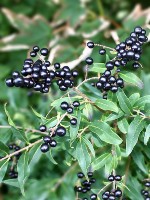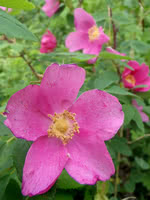Mon-Fri 9am - 5pm Mountain time
Hedge Rose vs Wild Privet
Ligustrum vulgare
Rosa rugosa x Rosa woodsii (Improved hybrid developed by PFRA)
NOT AVAILABLE THIS SEASON - MIGHT RETURN
Wild Privet is a fast growing ornamental shrub that is well suited for forming hedges and privacy screens. It will retain its leaves in warmer climates but drops them in colder areas. They have small white flowers, though the smell is often considered unpleasant. While the berries are inedible, they are a good food source for many bird species.
It is recommended to prune Wild Privet immediately after flowering, as it can readily self seed. It is deer and rabbit tolerant. It can grow in dry areas, on slopes, and withstand the wind making it well suited for many growing conditions.
Hedge Rose is a long-lived, fast-growing shrub. It bears similar flowers to the Alberta Wild Rose. Birds will love its deep red rose hips. Hedge Rose will thrive in a wide variety of soils and is a tall rose forming a useful hedge.
Excellent for shelterbelts, ecobuffers, and wildlife habitat plantings. Continuous flowering makes it attractive to pollinators. Many song and game birds utilize this tree for food and habitat.
In use since the early 1900s, this hybrid was originally developed at the PFRA's Indian Head Agroforestry Center.
Wild Privet Quick Facts
Hedge Rose Quick Facts
Toxicity: If ingested, all parts of this plant will cause severe discomfort. Toxic to dogs, cats, and horses
In row spacing: 0.3 m (1.0 ft)

